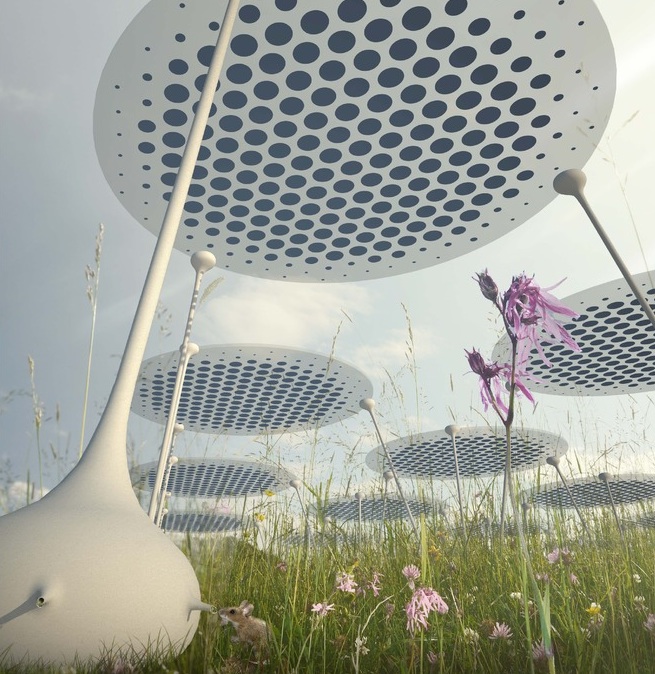After Sandy, rebuild Staten Island with art and power

Here’s a post-election political litmus test: Do you think wind generators, those massive pinwheels set on hilltops, are pretty? Say yes, and likely you’re a left-leaner, Al Gore type. Say no? You may be a Republican stalwart, maybe a Trump or Murdoch.
Or not. Maybe you’re just one of a growing number of artists and architects who think our power infrastructure lacks a certain aesthetic flair.

A few of these likeminded artsy types got together a competition to dream up new ideas for land art that would also generate power in New York City. The site? The massive Fresh Kills landfill on Staten Island.
In a city still without power in some places -- and with much of Staten Island in need of serious rebuilding, all due to Hurricane Sandy -- this is an ideas competition we really need.
Now.
Art that powers a city
And here it is: The results, unveiled last week, are fascinating and eye-popping.
Co-sponsored by the city’s Department of Parks & Recreation, the goal of the Land Art Generator Initiative (LAGI) is to build some very big public artworks that also generate very big amounts of clean, renewable energy.
Yes, these are sculptures that produce power for thousands of homes.
The winning submission envisaged creating piezoelectric energy from a wind-rippled metal mesh wall about 10 stories tall. The work, Scene-Sensorby James Murray and Shota Vashakmadze, both at Georgia Tech School of Architecture, captured first place and the $15,000 purse.
One visually stunning entrant was Heliofield, created by New York-based Michael Chaveriat, Yikyu Choe, and Myung Kweon Park, in which an array of solar modules rises “out of the prairie grasses.” (This is unlike the usual solar arrays, which coexist only with dirt.) At night, the modules glow and flicker.
Another scheme, by a team from Winnipeg, offers a poetic idea and a 1980s song title, 99 Red Balloons. The proposed 50-foot tall balloons “sway softly in the breeze” while capturing solar power in their organic resin membranes -- a cool MIT invention from back in 2008.
Wind turbine-topped skyscrapers?
This is the kind of design competition we’re used to seeing in Europe, not the United States.
But then again, New York is going positively Danish with its green power dreams. Mayor Bloomberg has lately fantasized about topping skscrapers and bridges with wind turbines. Last year, the city’s Department of Environmental Protection applied to lease a vast wind farm miles and miles off the coast of Queens; Bloomberg avidly supported it.
Smart idea. An MIT source estimates that it would take 4,000 wind turbines (at 5 megawatts each) to meet the city’s annual electrical consumption. Sounds almost feasible.
Net-zero architecture, too
There’s more to the idea of art that generates power, and architects should be in the thick of it. If you’re not (or not sure), please read on.
Net-zero energy buildings -- some call them NZEBs -- are an emerging class of super-green buildings that don’t consume power. If done right they should return power to the grid. The Living Building Challenge now offers a certification for zero-energy projects, similar to a LEED rating.
In fact, New York’s first NZEB has just been announced -- for Staten Island, of all places.
When it opens in 2015, Public School 62, a 444-seat primary school designed by Skidmore, Owings & Merrill for Richmond, Staten Island, will harvest solar energy from the photovoltaic arrays covering its roof and south façade.
Also key to the project’s success is an “ultra-tight, high-performance building envelope,” and lots of energy-efficient systems, such as lighting and heating. But it also has a geothermal system, solar hot-water collectors and closed-loop components like its energy recovery ventilators.
The school looks like the odd machine it is, draped over by a clunky, photovoltaic cheese grater. (It's no land art, yes, we understand.) But anyway the implications are huge: If Manhattan had just one NZEB on each city block, power use on the eastern seaboard would be cut by at least 1 gigawatt per year.*
Or if a nearby borough were to rebuild with sun-harvesting mega-balloons and solar prairie pods, all within view of a bridge made of piezoelectric pavilions?
Manhattan would finally find reason to be jealous.
----
*My estimate.
This post was originally published on Smartplanet.com